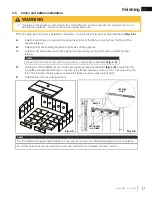
W415-2797 / A / 01.31.20
EN
8
general information
Your appliance was specifi cally designed to meet the 2020 U.S.A. EPA particulate emission standards for cord
wood and has been extensively tested in Canadian laboratories. This system is the most effi cient, simple and
trouble free we know and works as follows:
Your appliance is the exact duplication of the clean-burning technology found in all Napoleon EPA-certifi ed freestanding
stoves. External modifi cations have been made to allow its installation as a “functional insert” with a heat circulating blower
system and a means of enclosing the solid fuel burning fi replace cavity for greater heating effi ciency.
Your appliance must be installed only into a solid fuel burning fi replace that is at least 14” (356mm) deep 25 7/8” (657mm)
wide and 22” (559mm) high with an approved lined chimney at least 15 feet high (4.6m) and a hearth of 18” (457mm).
This minimum recess can only be achieved if the opening height is suffi cient enough to allow the connector to fi t under the
noncombustible facing. The appliance and chimney must be constructed in accordance with all national and local building
code standards.
The chimney vent system used on your wood burning appliance should be designed with the least amount of restriction
possible to enable the exhaust products to easily fl ow through it. Chimney vent systems that are too short or too
long can also have an adverse affect on the fl ow of exhaust through it. The wood burning appliance and chimney
vent system also require a suffi cient supply of combustion air not only to support the combustion in the combustion
chamber but to replace the exhaust leaving it so it can fl ow freely
up through the vent system and out into the atmosphere. It is the
correct balance of combustion air and the chimney vent system
that will ensure the appliance provides you with its optimum
performance.
Secondary air from the rear intake opening travels up the back in
the secondary air housing to the manifold located across the top
and fl ows out laterally to oxidize the gases below the smoke exit.
The lower combustion chamber is lined with high temperature
fi rebricks on 2 sides, the back and across the bottom, with a layer
of fi bre baffl es at the top to maintain a high temperature in the
combustion chamber so that gases mixing with the preheated
air from the secondary air manifold tube are easily ignited and
burned. The appliance sides and back are shielded to direct the
heat upwards and forwards into the room.
Be sure to provide suffi cient combustion air. There are many
other appliances in your home competing for air such as: a kitchen range hood, forced air heating devices or a
bathroom exhaust blower.
Expansion / contraction noises during heating up and cooling down cycles are normal and to be expected.
After extended periods of non-operation such as following a vacation or a warm weather season, the appliance
may emit a slight odour for a few hours. This is caused by dust
particles on the fi rebox burning off. Open a window to suffi ciently
ventilate the room.
If you experience smoking problems, you may need to open a
door, a window or otherwise provide some method of supplying
combustion air to the appliance.
We suggest that our woodburning hearth products
be installed and serviced by professionals who are
certified in the U.S. by the National Fireplace
Institute® (NFI) as NFI Woodburning Specialists or
who are certified in Canada by
Wood Energy Technical
Training (WETT).
1.4 general
information
AIR INLET PATH
EXHAUST PATH









































